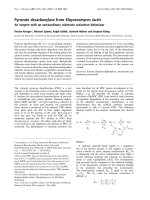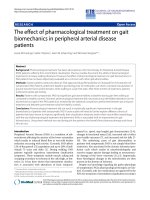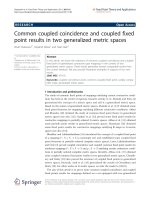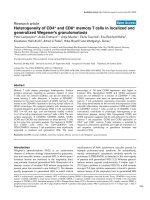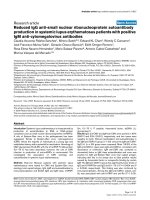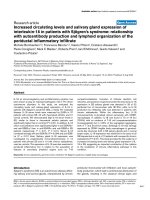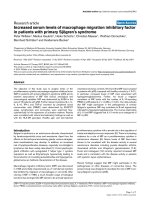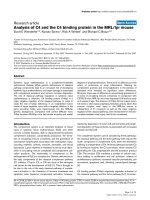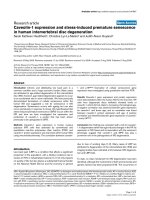Báo cáo y học: " Decreased glutathione levels and impaired antioxidant enzyme activities in drug-naive first-episode schizophrenic patients" pptx
Bạn đang xem bản rút gọn của tài liệu. Xem và tải ngay bản đầy đủ của tài liệu tại đây (250.24 KB, 7 trang )
RESEARC H ARTIC LE Open Access
Decreased glutathione levels and impaired
antioxidant enzyme activities in drug-naive
first-episode schizophrenic patients
Monia Raffa
1*
, Fatma Atig
1
, Ahmed Mhalla
2,3
, Abdelhamid Kerkeni
1
and Anwar Mechri
2,3
Abstract
Background: The aim of this study was to determine glutathione levels and antioxidant enzyme activities in the
drug-naive first-episode patients with schizophrenia in comparison with healthy control subjects.
Methods: It was a case-controlled study carried on twenty-three patients (20 men and 3 women, mean age = 29.3
± 7.5 years) recruited in their first-episode of schizophrenia and 40 healthy control subjects (36 men and 9 women,
mean age = 29.6 ± 6.2 years). In patients, the blood samples were obtained prior to the initiation of neuroleptic
treatments. Glutathione levels: total glutathione (GSHt), reduced glutathione (GSHr) and oxidized glutathione
(GSSG) and antioxidant enzyme activities: superoxide dismutase (SOD), glutathione peroxidase (GPx), catalase (CAT)
were determined by spectrophotometry.
Results: GSHt and reduced GSHr were significantly lower in patients than in controls, whereas GSSG was
significantly higher in patients. GPx activity was significantly higher in patients compared to control subjects. CAT
activity was significantly lower in patients, whereas the SOD activity was comparable to that of controls.
Conclusion: This is a report of decreased plasma levels of GSHt and GSHr, and impaired antioxidant enzyme
activities in drug-naive first-episode patients with schizophrenia. The GSH deficit seems to be implicated in
psychosis, and may be an important indirect biomarker of oxidative stress in schizophrenia early in the course of
illness. Finally, our results provide support for further studies of the possible role of antioxidants as neuroprotective
therapeutic strategies for schizophrenia from early stages.
Background
There is strong evidence that oxygen free radicals m ay
play an important role in the pathophysiology of major
mental illnesses such as schizophrenia [1,2]. Oxyradicals
have a very short life span and usually are inactivated or
scavenged by antioxidants before they can inflict damage
to lipids, proteins or nucleic acids. The human body has
a complex antioxidant defense system (AODS) that
includes the antioxidant enzymes: superoxide dismutase
(SOD), glutathione peroxidase (GPx) and catalase
(CAT). Also more important are the non-enzymatic
antioxidants such as glutathione (GSH). Cellular levels
of antioxidants respond to levels of oxygen and
oxyradicals; which enables cells to defend against
increased oxyradical production [3]. If produced in
excess, or not removed effectively, oxyradicals result in
cellular damage. SOD dismutates superoxide (O
2
·-
)to
yield hydrog en peroxide (H
2
O
2
)andoxygen(O
2
). H
2
O
2
is not an oxyradical because it does not have an
impaired electron, but it must b e promptly removed by
CAT [3]. Thus, high SOD activity, which results in
increased H
2
O
2
production, must b e accompanied by
increased GPx and/or CAT activity to limit injury [4].
GPx provides an effective mechanism against cy tosolic
injury because it eliminates H
2
O
2
and lipid peroxides
(products of
·
OH mediated peroxidation products) by
reduction utilizing GSH [5]. GPx converts peroxides and
hydroxyl radicals into nontoxic forms, often with the
concomitant oxidation of reduced glutathione (GSHr)
into the o xidized form glutathione disulfide (GSSG) and
glutathione reductase recycl es GSSG to GSH [4]. GSH
* Correspondence:
1
Research Laboratory of “Trace elements, free radicals and antioxidants”,
Biophysical Department, Faculty of Medicine, University of Monastir, Avicene
street, Monastir 5000, Tunisia
Full list of author information is available at the end of the article
Raffa et al. BMC Psychiatry 2011, 11:124
/>© 2011 Raffa et al; licensee BioMed Central Ltd. This is an Open Access article distributed under the terms of the Creative Commons
Attribution License ( which permits unrestricted use, distribution, and reprod uctio n in
any medium, provided the original work is properly cited.
and other thiol-containing groups also play critical roles
as antioxidants. GSH participates in the reduction of
oxyradicals and its levels in the brain are high especially
during early development [5].
Since oxidative stress is systematic and some of the
oxidative products of the brain tissue do end up in the
blood, peripheral indic es have been accepted to reflect
the brain oxidative injury [6]. However, there are con-
flicting data in the literature on the activities or levels of
antioxidant enzymes in patients with schizophrenia.
SOD activity in erythrocytes of schizophrenic patients
has been reported to be increased [7,8] decreased [9-11]
or unchanged [12,13]. GPx ac tivities have been reported
to be unchanged [3,9,14-16] but also increa sed [7,17] or
decreased [11,18,19] and CAT activity has been found
unchanged [3,13,16] increased [20,21] and decreased
[11,15,22]. GSH is the brain’ s dominant a ntioxidant
implicated in the pathophysiology of schizophrenia [23].
There is a 27% reduction in the c erebrospinal fluid
levels of GSH in untreated patients [24] and a similar
reduction (41%) in the caudate postmortem of schizo-
phrenic patients [25]. Previous studies recorded a signif-
icant decrease in the blood levels of total glutathione
(GSHt) [26], of GSHr [27] or of GSHt and GSHr [28] in
schizophrenic patients in comparison with controls.
Furthermore, increased risk of schizophrenia is asso-
ciated with polymorphisms of genes associated with
GSH synthesis [29,30]. To our knowledge, there are few
published studies that have evaluated the antioxidant
defense system (AODS) in the blood of first-episode
schizophrenic patients (FESP) and most of the studies
were conducted on p opulations of the patients with
chronic schizophrenia. Thus, it seemed interesting to
consider the medication status and the stage of schizo-
phrenia in the evaluation of the AODS changes that
manifest in patients.
The purposes of the pre sent study were (1) to assess
whether red blood cell (RBC) SOD, GPx, and CAT
activities, plasmatic GSHt, GSHr and GSSG levels were
altered in the drug-naive FESP as compared to control
subjects, (2) if so, to further test whether altered antioxi-
dant defenses were associated with clinical characteris-
tics of patients.
Methods
1. Subject selection and diagnosis
Twenty-three patients (20 men and 3 women) with a
mean age of 29.3 ± 7.4 years (range, 19-45) were
recruited in their first-episode of schizophrenia from
consecutive admissions at the psychiatric department of
the University Hospital of Monastir. They provisionally
had DSM-IV-TR criteria for schizophrenia (n = 9) and
sch izophreniform disorder (n = 14) based on the Struc-
tured Clinical Interview for DSM-IV-TR [31]. Diagnosis
was reconfirmed at 6 months by consensus. Healthy
control subjects (n = 45, 36 men a nd 9 women with a
mean age of 29.6 ± 6.2 years, range, 22-47) were
recruited from blood donors in the blood center of the
University Hospital of Monastir. Their current mental
status and personal or family history of any mental dis-
order was assessed by unstructured interviews.
The exclusion criteria considered for the two groups
were the same and included the following parameters:
seizure disorders, head injury with loss of consciousness,
dependence on alcohol and other substances (except
dependence on tobacco), vitamin supplementation fol-
lowed for 6 months prior to inclusion in the study, and
denial to take part in the present study. Additional
exclusion criteria for the con trol subjects included per-
sonal or family history of p sychosis . All subjects signed
informed consent after a full explanation of the study.
The study was approved by the Local Ethic Committee
of the University H ospital of Monastir. The demo-
graphic and clinical characteristics of the FESP and the
control subjects were summarized in Table 1. Age and
gender distribution of the subjects and smoking habit
did not differ between patients and controls (Table 1).
2. Biochemical procedures
Five milliliters of blood was drawn from control subjects
and FESP by simple venipuncture between 7.00 and 9.00
a.m. after overnight fasting and tobacco abstinence for >
12 h. For the patients the blood samples were obtained
prior to the initiation of neuroleptic treatments. The
samples were centrifuged for 10 min at 3500 rpm.
Plasma RBCs were then separated, aliquoted and stored
at -80°C until analysis. For all samples, each evaluated
parameter was assayed in duplicate. Throughout the
investigations the biochemical assays were conducted
blind of the available clinical information. The total
SOD activities were deter mined using pyrogallol as sub-
strate by the method of Marklund and Marklund [32].
This method is based on pyrogallol oxidation by the
Table 1 Demographic and clinical features of the patients
and the controls
Demographic and clinical
features
Patients
(N = 23)
Controls
(N = 45)
p-
values
Age (mean ± SD) (years)
Min-Max
29.3 ± 7.5
19-45
29.6 ±
6.2
22-47
0.995
Gender (male/female) 20/3 36/9 0.477
Smokers (%) 56.5 46.7 0.44
SAPS score (mean ± SD) 25.4 ± 12.2 -
SANS score (mean ± SD) 29.5 ±
16.5
-
Max: maximum, Min: minimum, SAPS: Scale for assessment of positive
symptoms, SANS: Scale for assessment of negative symptoms, SD: Standard
deviation.
Raffa et al. BMC Psychiatry 2011, 11:124
/>Page 2 of 7
superoxide anion (O
2
-
) and its dismutation by SOD.
One unit (U) of tot al SOD is defined as the amount of
enzyme required to inhibit the rate of pyrogallol autoxi-
dation by 50%. GPx activity was assayed by the subse-
quent oxidation of NADPH at 240 nm with t-buthyl-
hydroperoxide as substrate [33].While,CATactivity
was determined using the method described by Beers
and Sizer [34] by measuring hydrogen peroxide decom-
position at 240 nm. CAT u nits (U/mg hemoglobin)
were determined as mmol of H
2
O
2
consumed/s/mg
hemoglobin. The total hemoglobin content was mea-
sured as cyanmethaemogobine using the drabkin
method. The glutathione levels were measured spectro-
photometrically in deproteinized blood samples, by the
method of Akerboom and Sies [35], using 5,5 dithiobis
(2-nitrobenzoic acid). Absorbance values were compared
with standard curves generated from known amounts of
GSH standards.
3. Psychopathological assessment
Patients were rated for psychopathology using the Scale
for the Assessment of Positive Symptoms (SAPS) and
the Scale for the Assessment of Negative Symptoms
(SANS) [36]. The assessments were carried out by
trained psychologists.
4. Statistical analysis
The Windows computing prog ram Statistical Package
for the Social Sciences SPSS 10.0 [37 ] was used for ana-
lyzing the data. The obtained data was presented as
mean values ± standard deviation (SD) and were ana-
lyzed using nonparametric statistics. Specifically,
between groups, comparisons were examined using
Mann-Whitney tests. The adjusted analysis of variance
(ANOVA) was used in case the parameters of age, gen-
der, and the smoking habit of the subject were found to
have some effects on the levels of glutathione and the
activities of the antioxidant enzymes. Finally, the corre-
lations existing between the antioxidant systems and the
SAPS and SANS scores in our patients were calculated
by using Spearman correlation coefficients. The differ-
ences were considered significant at values of p ≤ 0.05.
Results
1. Antioxidant enzyme activities and glutathione levels
There was no significant correlation between age and
AODS included enzyme activities and glutathione levels,
in patients or healthy controls. Similarly, there was no
effect of gender on AODS, even thoug h the activities of
CAT and GPx were found to be affected by the smoking
habit of patients (U de Mann-Whitney = 24, p = 0.02
and U de Mann-Whit ney = 25, p = 0.04 respectively).
Thus, the differences that appeared in the activities of
RBC antioxidant CAT and GPx activ ities were tested by
execut ing an ANOVA adjusted by the smoking habit of
the subjects.
In this study, no significant difference was observed in
the RBC SOD activity between FESP and control sub-
jects. RBC GPx activity was significantly higher in
patients than in healthy controls with 68.6 ± 13.5 vs.
41.1 ± 26.3 U/g Hb (F
1-64
= 31.8, p < 0.001), but RBC
CAT activity was significantly lower in patients than in
controls with 212.2 ± 36.9 vs. 284.6 ± 88.2 U/g Hb (F
1-
64
= 14.8, p < 0.001) (Table 2). As shown in Table 3,
GSHt and GSHr levels were sig nificant ly lower in FESP
than in control group with values: 560.4 ± 123.6 μmol/l
vs. 759.5 ± 260.9 μmol/l (U de Mann-Wh itney = 214, p
= 0.001) for GSHt and 512.1 ± 117.7 μmol/l vs.732.2 ±
274.6 μmol/l (U de Mann-Whitney = 185, p < 0.001) for
GSHr, respectively. Whereas, GSSG was significantly
higher in patients than in controls (U de Mann-Whitney
= 270, p = 0.013) (Table 3). Additionally, we have not
found any significant differences between schizophreni-
form (n = 14) and schizophrenic patients (n = 9) in
terms of antioxidant enzyme activities and glutathione
levels.
2. Correlations between the antioxidant system and the
SAPS and SANS scores
Therewasapositivecorrelationbetweenthescoreof
SAPS and the levels of tGSH and rGSH (r = 0.50, p =
0.04; r = 0.51, p = 0.03, respectively). However, antioxi -
dant enzyme activities were not significantly correlated
to SAPS and SANS scores. Correlation coefficients
between SAPS, SOD, GPx and CAT were as follows (r =
-0.34; r = -0.11 and r = -0.11; respectively). Correlation
coefficients between SANS and SOD, GPx and CAT
wereasfollows(r=-0.12;r=-0.15andr=-0.12;
respectively) (Table 4).
Table 2 The activities of the RBC antioxidant enzymes in
the study groups
Antioxidant enzymes Patients
(N = 23)
Controls
(N = 45)
p-values
SOD (U/mg Hb)
Mean ± SD 2.2 ± 0.6 2.4 ± 0.6 0.2
Min-Max 1.5-3.8 1.7-4.6
GPx (U/gHb)
Mean ± SD 68.6 ± 13.5 41.1 ± 26.3 < 0.001*
Min-Max 28.2-122.6 22.9-70.7
CAT (U/gHb)
Mean ± SD 212.2 ± 36.9 284.6 ± 88.2 < 0.001*
Min-Max 157.3-282.5 100.3-499.3
CAT: catalase, GPx: glutathione peroxidase, Max: maximum, Min: minimum,
RBC: red blood cell, SD: standard deviation, SOD: superoxide dismutase.
*Adjusted by smoking habit
Raffa et al. BMC Psychiatry 2011, 11:124
/>Page 3 of 7
Discussion
The key results of the present study were: (1) the levels
of GSHt and GSHr significan tly decreased in the drug-
naïve FESP in comparison with the control subjects. (2)
the group of FESP revealed an increased activity of GPx
and a decreased activity of CAT in RBCs. (3) a positive
correlation exists between the score of SAPS and the
levels of GSHt and GSHr. The findings of this study
indicate that some FESP may be poorly equipped to
deal with oxi dative stress due to impaired antioxidant
defenses. Moreover, oxidative stress might play a role in
the brain’s developmental and maturational processes in
the pathogenic cascade of schizophrenia. The findings
reported above suggest such a possibility and call for
more systematic research on the role of o xidative stress
in schizophrenia.
The detailed neurochemical mechan isms underlying
the pathophysiology of schizophrenia are not clearly
understood. There has been accumulating evidence sup-
porting the involvement of oxidative stress in the patho-
physiology of this disease [2]. Prabakaran et al. [38]
reported that transcript, protein and metabolite altera-
tions are associated with the mitochondrial function and
oxidative stress in the cortex, the liver and the R BCs
of schizophrenic patients. The antioxidant system
eliminates reactive oxygen species to maintain a reduced
environment in cells through enzymatic or non-enzy-
matic approaches. The most studied antioxidants are
the SOD, GPx and CAT enzymes. Notably, CAT and
SOD, acting in concert with GPx, constitute the major
defense or primary antioxidant enzymes against super-
oxide radicals [39]. However, it is important to under-
line the contradictions and the controversial outcomes
found in the literature. In f act, these differences can be
due to several variables among which are inclusion and
exclusion criteria for patien t selection, analytical meth-
odologies, testing m aterials (blood cells vs. plasma or
serum ), exposure to medication (naïve vs. drug withdra-
wal vs. medicated), stages of the disease (acute vs.
chronic or active vs. remission phase), lifestyle or dietary
pattern, and the patient’ sorigin.Themainreasonfor
the difference between the current study and those pre-
viously reported [3,24,40], is likely to be the early stage
of illness of our patient sample. Also, our study focused
on drug-naïve FESP to show whether the oxidative dis-
turbances which occur during the course of the disease
can be related to the degenerative process linked to the
symptoms and/or treatment, or ra ther related to sc hizo-
phrenia and appear at an early stage of the disease. Stu-
dies comparing first-episode and chronic schizophrenic
patients would be necessary to further investigate a
stage-specific change in AODS in schizophrenia.
In our research, we tried t o explore the activities of
SOD, GPx and CAT in the RBCs of our collected sam-
ples of pat ients and controls. In the present study, we
found that the activity of SOD, a key enzyme in the
endoge nous antioxidant defense pathways, did not differ
between the FESP and controls. Similarly, Mico et al.
[41] found no significant difference in SOD activity
between early-onset first-psychosis group and the con-
trol group. Other studies have reported lower SOD
activity in neuroleptic-naïve FESP [3]. High levels of
blood SOD were reported in neuroleptic-naive schizo-
phrenic patients [8] and higher activities of SOD in neu-
roleptic-free schizophrenic patients in comparison with
the schizophrenic patients treated with halop eridol [13].
However, in our study, the levels of GPx were signifi-
cantly higher in the FESP than those in control subjects.
The same result observed in the early-onset first-episode
psycho sis by Mico et al [41]. Yao et al. [13] showed also
a significant increase in GPx activity in drug-free schizo-
phrenic patients compared to treated ones. In this case,
increased GPx antioxidant activ ity may reflec t a preced-
ing cellular oxidative stress or serve as a compensatory
mechanism. Interestingly, the CAT activity was signifi-
cantly lower in the RBCs of drug-naïve FESP than that
in control group. Other studies [3,41] showed no signifi-
cant difference in CAT activity between early-onset
first-psychosis patients and the control subjects. Raffa et
Table 3 Glutathione levels in the study group
Glutathione levels Patients
(N = 23)
Controls
(N = 45)
p-values
GSHt (μmol/l)
Mean ± SD 560.4 ± 123.6 759.5 ± 260.9 0.001
Min-max 402.9-821.2 430.6-1537
GSHr (μmol/l)
Mean ± SD 512.1 ± 117.7 732.2 ± 274.6 < 0.001
Min-max 402.9-821.2 374.8-1514.8
GSSG (μmol/l)
Mean ± SD 47.8 ± 18.1 35.4 ± 20.3 0.013
Min-max 10.6-76.6 6.5-73.2
GSHr: reduced glutathione, GSHt: total glutathione, GSSG: oxidized
glutathione, Max: maximum, Min: minimum, SD: standard deviation.
Table 4 The value of Spearman correlation coefficients
calculated between the antioxidant system and the SAPS
and SANS scores in drug free FESP
Antioxidant system SAPS scores SANS scores
Total glutathione 0.50* -0.02
Reduced glutathione 0.51* -0.05
Oxidized glutathione 0.16 0.17
Glutathione peroxidase -0.34 -0.12
Superoxide dismutase -0.11 -0.15
Catalase -0.13 -0.22
FESP: first-episode schizophrenic patients, SAPS: Scale for assessment of
positive symptoms, SANS: Scale for assessment of negative symptoms.
*p < 0.05
Raffa et al. BMC Psychiatry 2011, 11:124
/>Page 4 of 7
al. [28] found a significant decrease of CAT activity in
neuroleptic-free schizophrenic patients.
On the other hand, it is likely that oxidative stress
injury was due to an impaired antioxidant defense in
early stage of schizophrenia. Furthermore, because of
their impaired antioxidant defense, some patients might
be vulnerable to oxidative injury in spite of their normal
oxyradical producti on [42]. In recent decades, biochem-
ical studies have increasingly more often focused on the
role of free radicals in the pathogenic of neuropsychia-
tric diseases such as schizophrenia [43,44]. In addition
to the impaired antioxidant enzyme activities, we also
found a decreased plasma GSHt and GSHr levels in the
drug-naïve FESP. Previous studies recorded a significant
decrease in the RBC levels of GSHt [26] or of GSHr
[27] in schizophrenic patients in comparison with the
controls. Plasmatic GSH level was significantly lower in
the FESP [41], magnetic resonance spectroscopy studies
have shown that levels of GSH were reduced by 52% in
the prefrontal cortex and by 27% in the cerebrospinal
fluid of drug-naïve schizophrenic patients [24]. However,
a spectroscopy study showed that patients with first -epi-
sode psychosis had a higher concentration of G SH in
the medial temporal lobe than control group [23].
Anomalies in GSH metabolism were also supported by
the low expression of the gene of the key G SH-synthe-
sizing enzyme, glutamate cy steine ligase modifier subu-
nit, in patient fibroblasts [30]. The GSH deficit found in
this study and in previous reports [18,25,45 ,46] may be
involved in membrane peroxidation and microlesions
related to dopamine, which seem to be increased in psy-
chosis, and suggest that GSH may be a possible indirect
indicator of damage in neuronal membranes [47,48].
This study of the drug-naïve FESP also suggests that the
deficit in GSH may underlie the pathophysiology of the
disease and is not a consequence of treatment. The con-
verging data in literature, in agreement with our results
in FESP, indicate that psychosis is associated with an
important brain glutathione deficit. In fact, it could be
hypothesized that different etiological mechanisms con-
verge into precipitating a first psychotic episode in indi-
viduals with a limited GSH synthesis capacity, after
which the psychotic episode develops into a degenerat-
ing condition that we call schizophrenia. This could b e
tested by analyzing glutathione in high-risk populations
that are subsequently followed up.
In our patient group, using the SAPS, the presence of
positive symptoms was associated with high er levels of
GSHt and GSHr. Positive symptoms are associated
with subcortical dopamine hyperactivity i n schizophre-
nia [49]. Several studies have revealed that catechola-
mines, especially dopamine, are associated with free
radical generation [47-49]. As s uggested in the present
study, this may serve as a compensatory or protective
mechanism employed to neutralize oxidative stress
produced from presumably supra-physiological pre-
frontal dopamine. Therefore, the h yperdopaminergic
state in schizophrenia, induced by still unknown
mechanisms, may explain the positive association
between positive symptoms and GSH levels in the pre-
sent study. Although, we should be cautious, our find-
ings support the possibility of using peripheral markers
of oxidative and antio xidative system in FESP, taki ng
into account the special sensitivity of the brain to oxi-
dative damage [50].
This study has some limitations. Diagnostic groups
were relatively small, and it was difficult to establish in
advanceasamplesizetoperformthedataanalyses
because of the paucity of studies with similar design
characteristics. A second limitation was the used sam-
ples were limited to blood ones. Because the data pre-
sents changes in peripheral blood, further work is
needed to determine if such changes adequately reflect
changes in the brain. Although, recent findings have
identified a genetic origin of GSH deficit, which results
in the impairment of the GSH synthesis in patients diag-
nosed with schizophrenia [51]. The decreased levels of
GSH and/or the activities of antioxidant enzymes in the
peripheral blood of the patients may indicate the occur-
rence of a systematic reaction that may cause oxidative
stress in the brain of schizophrenicpatientsasisthe
case in other disorders of the central nervous system
[52]. The strengths of the study are the uniformity in
age with first-episode and drug-naïve of schizophrenic
patients, and the existence of a control group.
Conclusion
In summary, our study shows that there is impairment
in the AODS in drug-naive FESP. GSH deficit seems to
be implicated in psychosis, and may b e an important
indirect biomarker of oxidative stress in first-episode o f
schizophrenia. Our results provide support for further
studies of the possible role of antioxidants as neuropro-
tective therapeutic strategies for schizophrenia from
early stages [6]. Data from the longitudinal study will
clarify the possible utility o f peripheral markers of oxi-
dative stress as prog nostic factors and the effect of neu-
roleptic drugs on oxidative stress.
Abbreviations
(AODS): Antioxidant defense system; (CAT): Catalase; (DSM-IV-TR): Diagnostic
and statistical manual of mental disorders; (FESP): First-episode-
schizophrenic-patients; (GPx): Glutathione peroxidise; (GSHr): Reduced
glutathione; (GSHt): Total glutathione; (GSSG): Oxidized glutathione; (Max):
Maximum; (Min): Minimum; (RBC): Red blood cell; (SANS): Scale for
assessment of negative symptoms; (SAPS): Scale for assessment of positive
symptoms; (SD): Standard deviation; (SOD): Superoxide dismutase.
Raffa et al. BMC Psychiatry 2011, 11:124
/>Page 5 of 7
Acknowledgements
We want to thank Mr. Moncef Rassas (English department, Faculty of
Medicine, Monastir, Tunisia) for his editorial assistance.
Author details
1
Research Laboratory of “Trace elements, free radicals and antioxidants”,
Biophysical Department, Faculty of Medicine, University of Monastir, Avicene
street, Monastir 5000, Tunisia.
2
Research Laboratory of “Vulnerability to
psychotic disorders”, Faculty of Medicine, University of Monasti r, Avicene
street, Monastir 5000, Tunisia.
3
Department of Psychiatry, University Hospital
of Monastir, Avicene street, Monastir 5000, Tunisia.
Authors’ contributions
All the authors made substantial contributions to the design and conception
of the study. Particularly, MR wrote the manuscript, contributed to the
analysis and interpretation of the data. AM conceived of the study, and
participated in its design and coordination and helped to draft the
manuscript. AK contributed to the development of the protocol and study
instruments. All the authors have been involved in drafting and revising the
manuscript, have read, and approved the final manuscript.
Competing interests
The authors declare that they have no competing interests.
Received: 28 April 2011 Accepted: 2 August 2011
Published: 2 August 2011
References
1. Zhang M, Zhao Z, He L, Wan C: Ameta-analysis of oxidative stress
markers in schizophrenia. Sci China Life Sci 2010, 53:112-124.
2. Bitanihirwe Byron KY, Woo Tsun-Ung W: Oxidative stress in schizophrenia:
An integrated approach. Neuroscience and Biobehavioral 2011, 35:878-893.
3. Mukherjee S, Mahadik SP, Scheffer R, Correnti EE, Kelkar H: Impaired
antioxidant defense at the onset of psychosis. Schizophr Res 1996,
19:19-26.
4. Drevet JR: The antioxidant glutathione peroxidase family and
spermatozoa: A complex story. MCE. Essent Fatty Acids 2006, 55:45-54.
5. Burton G J, Jauniaux E: Oxidative stress. Best Pract Res Clin Obstet Gynaecol
2010.
6. Mahadik SP, Pillai A, Joshi S, Foster A: Prevention of oxidative stress-
mediated neuropathology and improved clinical outcome by adjunctive
use of a combination of antioxidants and omega-3 fatty acids in
schizophrenia. Int Rev Psychiatry 2006, 18:119-131.
7. Kuloglu M, Ustundag B, Atmaca M, Canatan H, Tezcan AE, Cinkilinc N: Lipid
peroxidation and antioxidant enzyme levels in patients with
schizophrenia and bipolar disorder. Cell Biochem Funct 2002, 20:171-175.
8. Zhang XY, Zhou DF, Cao LY, Chen DC, Zhu FY, Wu GY: Blood superoxide
dismutase level in schizophrenic patients with tardive dyskinesia:
association with dyskinetic movements. Schizophr Res 2003, 62:245-250.
9. Akyol O, Herken H, Uz E, Fadillioglu E, Unal S, Sogut S, Ozyurt H, Savaş HA:
The indices of endogenous oxidative and antioxidative processes in
plasma from schizophrenic patients. The possible role of oxidant/
antioxidant imbalance. Prog Neuropsychopharmacol Biol Psychiatry 2002,
26:995-1005.
10. Zhang XY, Tan YL, Cao LY, Wu GY, Xu Q, Shen Y, Zhou DF: Antioxidant
enzymes and lipid peroxidation in different forms of schizophrenia
treated with typical and atypical antipsychotics. Schizophr Res 2006,
81:291-300.
11. Ben Othmen L, Mechri A, Fendri C, Bost M, Chazot G, Gaha L, Kerkeni A:
Altered antioxidant defense system in clinically stable patients with
schizophrenia and their unaffected siblings. Prog Neuro-psychopharmacol
Biol Psychiatry 2008, 32:155-159.
12. Herken H, Uz E, Ozyurt H, Sogut S, Virit O, Akyol O: Evidence that the
activities of erythrocyte free radical scavenging enzymes and the
products of lipid peroxidation are increased in different forms of
schizophrenia. Mol Psychiatry 2001, 6:66-73.
13. Yao JK, Reddy R, Mc Elhinny LG, Van Kammen DP: Effects of haloperidol
on antioxidant defense system enzymes in schizophrenia. J Psychiatr Res
1998, 32:385-391.
14. Yao JK, Reddy RD, Van Kammen DP: Human plasma glutathione
peroxidase and symptom severity in schizophrenia. Biol Psychiatry 1999,
45:1512-1515.
15. Reddy R, Sahebarao MP, Mukherjee S, Murthy JN: Enzymes of the
antioxidant defense system in chronic schizophrenic patients. Biol
Psychiatry 1991, 30:409-412.
16. Srivastava N, Barthwal MK, Dalal PK, Agarwal AK, Nag D, Srimal RC, Seth PK,
Dikshit M: Nitrite content and antioxidant enzyme levels in the blood of
schizophrenia patients. Psychopharmacology (Berl) 2001, 158:140-145.
17. Dakhale G, Khanzode S, Khanzode S, Saoji A, Khobragade L, Turankar A:
Oxidative damage and schizophrenia: the potential benefit by atypical
antipsychotics. Neuropsychobiology 2004, 49:205-209.
18. Ranjekar PK, Hinge A, Hegde MV, Ghate M, Kale A, Sitasawad S, Wagh UV,
Debsikdar VB, Mahadik SP: Decreased antioxidant enzymes and
membrane essential polyunsaturated fatty acids in schizophrenic and
bipolar mood disorder patients. Psychiatry Res 2003, 121:109-122.
19. Carmeli E, Bachar A, Barchad S, Morad M, Merrick J: Antioxidant status in
the serum of persons with intellectual disability and hypothyroidism: a
pilot study. Res Dev Disabil 2008, 29:431-438.
20. Evans DR, Parikh VV, Khan MM, Coussons C, Buckley PF, Mahadik SP: Red
blood cell membrane essential fatty acid metabolism in early psychotic
patients following antipsychotic drug treatment. Prostaglandins Leukot
Essent Fatty Acids 2003, 69:393-399.
21. Pulido R, Jimenez-Escrig A, Orensanz L, Saura-Calixto F, Jimenez-Escrig A:
Study of plasma antioxidant status in Alzheimer’s disease. Eur J Neurol
2005, 12:531-535.
22. Ustundag B, Atmaca M, Kirtas O, Selek S, Metin K, Tezcan E: Total
antioxidant response in patients with schizophrenia. Psychiatry Clin
Neurosci 2006, 60:458-464.
23. Wood SJ, Berjer GE, Wellard RM, Proffitt TM, Mc Conchie M, Berk M, et al:
Medial tempral lobe glutathione concentration in first episode
psychosis: A
1
H-MRS investigation. Neurobiol Dis 2009, 3:354-357.
24. Do KQ, Trabesinger AH, Kirsten-Kruger M, Lauer CJ, Dydak U, Hell D,
Holsboer F, Boesiger P, Cuénod M: Schizophrenia: glutathione deficit in
cerebrospinal fluid and prefrontal cortex in vivo. Eur J Neurosci 2000,
12:3721-3728.
25. Yao JK, Leonard S, Reddy R: Altered glutathione redox state in
schizophrenia. Dis Markers 2006, 22:83-93.
26. Pavlovic D, Tamburic V, Stojanovic I, Kocic G, Jevtovic T, Dordevic V:
Oxidative stress asmarkers of positive symptoms in schizophrenia. Med
Biol 2002, 9:157-161.
27. Altuntas I, Aksoy H, Coskun I, Cayköylü A, Akçay F: Erythrocyte superoxide
dismutase and glutathione peroxidase activities, and malondialdehyde
and reduced glutathione levels in schizophrenic patients. Clin Chem Lab
Med 2000, 38:1277-1281.
28. Raffa M, Mechri A, Othman LB, Fendri C, Gaha L, Kerkeni A: Decreased
glutathione levels and antioxidant enzyme activities in untreated and
treated schizophrenic patients. Prog Neuropsychopharmacol Biol Psychiatry
2009, 33:1178-1183.
29. Saadat M, Mobayen F, Farrashbandi H: Genetic polymorphisms of
glutathione S-transferase T1: a candidate genetic modifier of individual
susceptibilty to schizophrenia. Psychiatry Res 2007, 153:87-91.
30. Tosic M, Ott J, Barral S, Bovet P, Deppen P, Gheorghita F, et al:
Schizophrenia and oxidative stress: glutamate cysteine ligase modifier as
a susceptibility gene. Am J Hum Genet 2006, 79:586-592.
31. American Psychiatric Association: DSM-IV-TR. Diagnostic and Statistical
Manual of mental disorders. fourth edition. Washington DC: American
Psychiatric Press; 2000.
32. Marklund S, Marklund G: Involvement of the superoxide anion radical in
the autoxidation of pyrogallol and a convenient assay for superoxide
dismutase. Eur J Biochem 1974, 47:469-474.
33. Gunzler WA, Kremers H, Flohe L: An improved coupled test procedure for
glutathione peroxidase in blood. Z Klin Biochem 1974, 12:444-448.
34. Beer B, Sizer W: A spectrophotometry method for measuring the
breakdown of hydrogen peroxide by catalase. J Biol Chem 1952,
195:133-139.
35. Akerboom TP, Sies DH: Assay of glutathione, glutathione disulfide and
glutathione mixed disulfides in biological samples. In Methods enzymol
detoxification and drug metabolism: conjugation and related systems. Edited
by: Jakoly W. London: Academic Press; 1981:373-382.
Raffa et al. BMC Psychiatry 2011, 11:124
/>Page 6 of 7
36. Andreasen NC: Scale for the Assessment of Negative Symptoms University of
Iowa, Iowa City IA; 1983.
37. SPSS.10.0 statistical package for the Social sciences (SPSS) for windows,
version 10.0 Chicago.IL: SPSS Inc; 1994.
38. Prabakaran S, Swatton JE, Ryan MM, Huffaker SJ, Huang JT, et al:
Mitochondrial dysfunction in schizophrenia: evidence for compromised
brain metabolism and oxidative stress. Mol Psychiatry 2004, 7:684-697.
39. Matsuzawa D, Obata T, Shirayama Y, Nonaka H, Kanazawa Y, Yoshitome E,
Takanashi J, Matsuda T, Shimizu E, Ikehira H, Iyo M, Hashimoto K: Negative
correlation between brain glutathione level and negative symptoms in
schizophrenia: a 3T 1H-MRS study. PLoS ONE 2008, 4:e1944.
40. Terpstra M, Vaughan TJ, Ugurbil K, Lim KO, Schulz SC, Gruetter R: Validation
of glutathione quantitation from STEAM spectra against edited 1H NMR
spectroscopy at 4T: application to schizophrenia. MAGMA 2005,
18:276-282.
41. Mico JA, Rojas-Corrales MO, Gibert-Rahola J, Parellada M, Moreno D,
Fraguas D, et al: Reduced antioxidant defense in early onset first-episode
psychosis: a case control study. BMC Psychiatry 2011, 11:26.
42. Mahadik SP, Mukherjee S, Correnti EE, Scheffer R: Elevated levels of lipid
peroxidation production plasma of drug-naive patients at the onset of
psychosis. Schizophr Res 1995, 15:66.
43. Mahadik SP, Mukherjee S: Free radical pathology and antioxidant defense
in schizophrenia: a review. Schizophr Res 1996, 19:1-17.
44. Ersan S, Bakir S, Erdal Ersan E, Dogan O: Examination of free radical
metabolism and antioxidant defense system elements in patients with
obsessive-compulsive disorder. Prog neuropsychopharmacol Biol Psychiatry
2006, 6:1039-1042.
45. Ozcan ME, Gulec M, Ozerol E, Polat R, Akyol O: Antioxidant enzyme
activities and oxidative stress in affective disorders. Int Clin
Psychopharmacol 2004, 19:89-95.
46. Machado-Vieira R, Andreazza AC, Viale CI, Zanatto V, Cereser V Jr, Da Silva V,
et al: Oxidative stress parameters in unmedicated and treated bipolar
subjects during initial manic episode: a possible role for lithium
antioxidant effects. Neurosci Lett 2007, 421:33-36.
47. Baez S, Segura-Aguilar J, Widersten M, Johansson AS, Mannervik B:
Glutathione transferases catalyse the detoxication of oxidized
metabolites (o-quinones) of catecholamines and may serve as an
antioxidant system preventing degenerative cellular processes. Biochem
J 1997, 324:25-28.
48. Stokes AH, Hastings TG, Vrana KE: Cytotoxic and genotoxic potential of
dopamine. J Neurosci Res 1999, 55:659-665.
49. Davis KL, Kahn RS, Ko G, Davidson M: Dopamine in schizophrenia: a
review and reconceptualization. Am J Psychiatry 1991,
148:1474-1486.
50. Ng F, Berk M, Dean O, Bush AI: Oxidative stress in psychiatric disorders:
evidence base and therapeutic implications. Int J Neuropsychopharmacol
2008, 11:851-876.
51. Gysin R, Kraftsik R, Sandell J, Bovet P, Chappuis C, Conus P, et al: Impaired
glutathione synthesis in schizophrenia: convergent genetic and
functional evidence. Proc Natl Acad Sci USA 2007, 104:16621-16626.
52. Younes-Mhenni S, Frih-Ayed M, Kerkeni A, Bost M, Chazot G: Peripheral
blood markers of oxidative stress in Parkinson’s disease. Eur Neurol 2007,
58:78-83.
Pre-publication history
The pre-publication history for this paper can be accessed here:
/>doi:10.1186/1471-244X-11-124
Cite this article as: Raffa et al.: Decreased glutathione levels and
impaired antioxidant enzyme activities in drug-naive first-episode
schizophrenic patients. BMC Psychiatry 2011 11:124.
Submit your next manuscript to BioMed Central
and take full advantage of:
• Convenient online submission
• Thorough peer review
• No space constraints or color figure charges
• Immediate publication on acceptance
• Inclusion in PubMed, CAS, Scopus and Google Scholar
• Research which is freely available for redistribution
Submit your manuscript at
www.biomedcentral.com/submit
Raffa et al. BMC Psychiatry 2011, 11:124
/>Page 7 of 7
